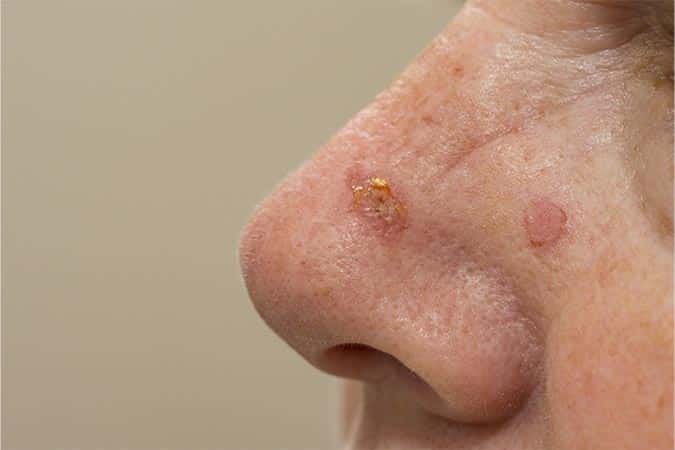What is Squamous Cell Carcinoma?
Squamous cell carcinoma is a common form of skin cancer that originates in the keratinocytes of the skin. While this form of skin cancer is typically not life-threatening, it can sometimes be aggressive and can result in metastatic disease. If it is left untreated, it can grow and spread to other areas of the body. It most often occurs on areas of the skin that are often exposed to the sun, including the face, scalp, ears, backs of the hands, and lips. However, it can also occur in other areas of the body.
Common signs of squamous cell carcinoma include:
- A flat sore with a scaly crust
- A red, firm nodule
- A new or raised sore that appears on an old scar or ulcer
- A scaly, rough patch on the lips
- Red, open sores
- White or red patches inside of the mouth or on the genitals
Individuals with fair skin, excessive sun exposure, who use tanning beds, have a history of sunburns, have a history of HPV, or a personal history of skin cancer may have an increased risk of skin cancers.
Who is a Good Candidate for Squamous Cell Carcinoma Treatment?
If you have a scab or sore that does not heal or a flat area of scaly skin that will not go away, it is important to see a dermatologist for assessment. A consultation appointment is the first step when seeing a dermatologist; during this appointment your doctor will examine your skin, leading to a diagnosis. A treatment plan that is right for you will then be created.
What to Expect During Squamous Cell Carcinoma Treatment?
In order to diagnose squamous cell carcinoma, a physical exam will be performed. In some cases, a biopsy is also done to ensure a proper diagnosis. The treatment that is right for you will depend on the location, size, and aggressiveness of your skin cancer. These treatments include:
Simple excision: Your dermatologist will remove the cancerous tissue and a surrounding margin of healthy skin. This margin of skin will be sent to a laboratory to ensure that all cancer cells have been removed.
Mohs surgery: The skin cancer is removed layer by layer, with each layer being examined under a microscope until none remain.
Cryosurgery: Liquid nitrogen is used to freeze the cancer cells. This treatment option is usually best for treating superficial skin lesions.
Curettage and electrodesiccation: The surface of the skin cancer is scraped away using an instrument called a curet, and then the base of the cancer is seared with an electric needle. This technique is often used for small or very superficial skin cancers.
Radiation therapy: Utilized for individuals, especially geriatric patients, who may not be good candidates for surgical treatments.
Following Squamous Cell Carcinoma Treatment
Following treatment, the squamous cell carcinoma should be completely cured. Downtime will depend on the treatment technique that was used and how large your cancer was. Your dermatologist will provide you with specific instructions on how to properly care for your treatment site following your procedure. If you have any post-treatment questions, do not hesitate to contact our office.
Schedule a Consultation
If you have a suspicious-looking lesion on your skin, do not hesitate to contact our office today to schedule a consultation with a dermatology provider. We will be happy to answer any questions that you may have for a comfortable visit. Our providers are adept in the diagnosis and treatment of skin cancer.

Get Started With A Visit!
Fill out the form below and we will reach out to you shortly to schedule an appointment.